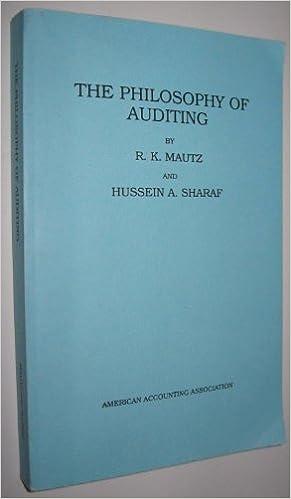Question
1.Accounting for fixed assets at historical cost a. is reliable, b. is verifiable, c. is objective, d. All of the above are true, e. None
1.Accounting for fixed assets at historical cost a. is reliable, b. is verifiable, c. is objective, d. All of the above are true, e. None of the above are true.
2. An asset is classified as a capital asset if a. it is purchased from another entity either by transfer of assets or by the promise to surrender assets at some future date, b. its value remains fixed over its useful life, c. it provides benefits longer than one year or one operating cycle. d. competitive buyers will bid the price of the asset to the point at which the acquisition cost equals the present value of the future cash flows.
3. Macaroni Co. purchased a parcel of land on January 1, 2000, for $100,000. The broker's commission was $1,000; the company spent $25,000 installing sewers and street lights; and the company installed a parking lot at a cost of $15,000. The amount that should be capitalized to the Land account is a. $100,000. b. $116,000. c. $126,000. d. $140,000.
4.Overhead incurred in conjunction with a self-constructed asset is a. not allocated to the asset, b. charged to the asset based on its proportionate fair share of fixed manufacturing overhead, c. charged to the asset only if it is an identifiable, incremental amount of fixed overhead. d. only a and b above, e. none of the above.
5.Interest incurred in conjunction with self-constructed assets is a. capitalized to the asset account if certain conditions are met. b. charged to expense over the life of the asset as depreciation expense, c. expensed immediately, d. only a and b above, e. none of the above.
6. The total cost capitalized on a self-constructed asset a. can never exceed the asset's fair market value, b. can never exceed average accumulated expenditures for a period, c. is the sum of direct labor and direct materials, d. is the lesser of book value or appraisal value.
7. On January 1, 2000, Grill Company acquired an asset with a book value of $12,000 from Chess Co. in exchange for a $15,000 noninterest-bearing note payable. Chess Co. had originally paid $16,000 for the asset which had a current market value of $13,000. Grill Company should record this asset on its books at a. $12,000. b. $13,000. c. $15,000. d. $16,000.
8. In an exchange of assets, a gain may be recognized if a. the assets are similar and cash is paid out. b. the assets are similar and cash is received, c. the assets are similar and book value exceeds fair market value, d. the assets are dissimilar and book value exceeds fair market value.
9. Choose the false statement from the following: a. In an exchange of similar assets, no gains or losses are recognized unless cash is received, and then only partially, b. In an exchange of dissimilar assets, all gains and losses are recognized in full and immediately, c. When assets are exchanged, the basis is the negotiated exchange value or fair market value, d. All of the above are false.
10. On July 8, 2000, Dually Corp. issues 5,000 shares of $15 par value common stock to Knob Company in exchange for a building. Dually's stock is selling on an organized exchange for $17 per share. Knob paid $78,000 for the building six months ago, but has had the building appraised at $90,000. At what amount should Dually record this building on July 8, 2000? a. $75,000 b. $78,000 c. $85,000 d. $90,000
Step by Step Solution
There are 3 Steps involved in it
Step: 1

Get Instant Access to Expert-Tailored Solutions
See step-by-step solutions with expert insights and AI powered tools for academic success
Step: 2

Step: 3

Ace Your Homework with AI
Get the answers you need in no time with our AI-driven, step-by-step assistance
Get Started


